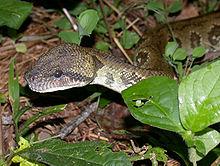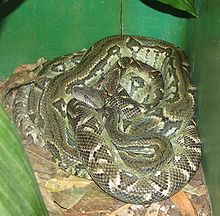- Boa manditra
-
Boa manditra 
Conservation status Scientific classification Kingdom: Animalia Phylum: Chordata Subphylum: Vertebrata Class: Reptilia Order: Squamata Suborder: Serpentes Family: Boidae Subfamily: Boinae Genus: Boa Species: B. manditra Binomial name Boa manditra
Kluge, 1991Synonyms - Xiphosoma Madagascariense - A.M.C. Duméril & Bibron, 1844
- Sanzinia Madagascariensis - Gray, 1849
- Corallus madagascariensis - Boulenger, 1893
- Boa mandrita - Kluge, 1991[1]
Boa manditra (also known as the Malagasy tree boa,[2] or Madagascar tree boa) is a non-venomous boa species endemic to the island of Madagascar. The specific epithet is also the Malagasy common name for this snake. No subspecies are currently recognized.[3]
Contents
Description
Adults average 4–5 feet (122–152 cm) in length, although 6–7 foot (183–213 cm) specimens are not uncommon. Thermoreceptive pits are located between the labial scales.[2] Females are larger than males.
There are two color variations that are considered by some to represent two distinct subspecies. One is green to grayish-green and is found mainly in the eastern half of the range, while the other is yellow, orange and brown and occurs in some parts of the western side of the range. The green variant also tends to be about two thirds of the size of the yellow-brown variant.
Geographic range
Endemic to Madagascar. The type locality given is "Madagascar."[1]
Habitat
Favors trees and shrubs near streams, rivers, ponds and swamps.[2]
Conservation status
This species is classified as Vulnerable (VU) on the IUCN Red List of Threatened Species with the following criteria: A1cd (v2.3, 1994).[4] This means that a population reduction of at least 20% has been observed, estimated, inferred or suspected over the last 10 years or three generations, whichever is the longer, based on a decline in area of occupancy, extent of occurrence and/or quality of habitat, and based on actual or potential levels of exploitation. Year assessed: 2006.[5]
Also listed as CITES Appendix I, which means that it is threatened with extinction and CITES prohibits international trade except when the purpose of the import is not commercial, for example for scientific research.[6]
Feeding
Arboreal and generally nocturnal, it feeds on bats and birds. Its thermoreceptive pits help it to locate its prey. It will also leave the trees to actively hunt for small mammals on the ground.[2]
Reproduction
Ovoviviparous, females give birth to up to 12 young at a time, each about 15 inches (38 cm) in length.[2]
When females become gravid, their skin color darkens. This adaptation provides increased heat absorption for the developing young. After giving birth, the color returns normal as soon as it next sheds its skin. Neonates are a bright red that may warn predators to "stay away", while simultaneously providing camouflage among brightly colored treetop flowers.
Taxonomy
When Kluge (1991) moved Sanzinia madagascariensis (Duméril & Bibron, 1844) to Boa together with Acrantophis madagascariensis (Duméril & Bibron, 1844), this resulted in homonymy. To fix this nomenclatural problem, he proposed the specific name manditra as a replacement for S. madagascariensis.[1]
However, it was later found that the Malagasy boids and Boa constrictor do not form a monophyletic group, so that the lumping of Sanzinia, Acrantophis and Boa were probably in error, and most recent authors have reverted to the use of Sanzinia madagascariensis as the name for this species.[7][8]
Some sources consider the two color variants to represent two distinct subspecies:
- B. m. manditra - Kluge, 1991
- B. m. volontany - Vences and Glaw, 2004.
See also
- List of boine species and subspecies
- Boinae by common name
- Boinae by taxonomic synonyms
References
- ^ a b c McDiarmid RW, Campbell JA, Touré T. 1999. Snake Species of the World: A Taxonomic and Geographic Reference, vol. 1. Herpetologists' League. 511 pp. ISBN 1-893777-00-6 (series). ISBN 1-893777-01-4 (volume).
- ^ a b c d e Mehrtens JM. 1987. Living Snakes of the World in Color. New York: Sterling Publishers. 480 pp. ISBN 0-8069-6460-X.
- ^ "Boa manditra". Integrated Taxonomic Information System. http://www.itis.gov/servlet/SingleRpt/SingleRpt?search_topic=TSN&search_value=634789. Retrieved 10 July 2008.
- ^ Sanzinia madagascariensis at the IUCN Red List. Accessed 10 July 2008.
- ^ 1994 Categories & Criteria (version 2.3) at the IUCN Red List. Accessed 10 July 2008.
- ^ Sanzinia madagascariensis at CITES and United Nations Environment Programme / World Conservation Monitoring Centre. Accessed 10 July 2008.
- ^ Vences, M., Glaw, F., Kosuch, J., Boehme, W., Veith, M. (2001) Phylogeny of South American and Malagasy boine snakes: Molecular evidence for the validity of Sanzinia and Acrantophis and biogeographic implications. Copeia 2001, 1151-1154
- ^ Noonan, B.O., Chippindale, P.T. (2006) Dispersal and vicariance: the complex history of boid snakes. Molecular Phylogenetics and Evolution, 40, 347-358.
Further reading
- Kluge AG. 1991. Boine Snake Phylogeny and Research Cycles. Misc. Pub. Museum of Zoology, Univ. of Michigan No. 178. 58 pp. PDF at University of Michigan Library. Accessed 11 July 2008.
- Vences M, Glaw F, Kosuch J, Böhme W, Veith M. 2001. Phylogeny of South American and Malagasy Boine Snakes: Molecular Evidence for the Validity of Sanzinia and Acrantophis and Biogeographic Implications. Copeia No 4. p. 1151-1154. PDF at Miguel Vences. Accessed 29 August 2008.
- Vences M, Glaw F. 2003. Phylogeography, systematics and conservation status of boid snakes from Madagascar (Sanzinia and Acrantophis). Salamandra, Reinbach, 39(3/4): p. 181-206. PDF at Miguel Vences. Accessed 29 August 2008.
External links
- Sanzinia madagascariensis at the Reptarium.cz Reptile Database. Accessed 10 July 2008.
Categories:- IUCN Red List vulnerable species
- Boinae
Wikimedia Foundation. 2010.


